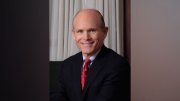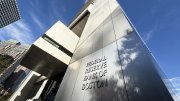As the pandemic spread suffering around the globe, it perversely improved the University’s finances: the $406-million operating surplus realized in the fiscal year ended June 30, 2022, was the largest to date. That result, disclosed in the annual financial report, released on October 13, brings the cumulative black ink for the three academic years shadowed by COVID-19 to more than $900 million—against initial expectations of daunting deficits. But the inflation and rising interest rates since last spring had an opposite effect on the endowment: following the 33.6 percent investment return realized in fiscal 2021, Harvard Management Company (HMC) reported a negative return of 1.8 percent in the most recent year. Combined with distributions to fund Harvard’s operating budget, that reduced the value of the endowment at year-end by 4.3 percent, to $50.9 billion.
In their annual letter, vice president for finance and chief financial officer Thomas J. Hollister and University treasurer Paul J. Finnegan wrote that after two consecutive years of declining income, “Revenues this past year rebounded” (rising a robust 11.2 percent). After contracting in the two prior years, operating “Expenses rebounded as well…although rising less than revenues due to comparatively high vacancy rates in staff as well as sourcing challenges with goods and services.”
In short, students who deferred admission or took leaves during the 2020-2021 year of remote instruction returned to campus in large numbers (College enrollment grew from a depressed 5,200 to an outsized 7,095). Net student income, $888 million in fiscal 2021, soared to $1.22 billion last year. Continuing and executive education revenue rose nearly $100 million, to $487 million—approaching the peak level of $516 million in fiscal 2019.
Sponsored support for research grew about 5 percent, to $976 million. Operating distributions from the endowment rose about 4 percent, to $2.1 billion. And current-use giving held nearly even, at more than a half-billion dollars.
With students back and paying their term bills, Harvard’s financial profile resumed its customary look. For fiscal 2022, endowment distributions contributed 36 percent of revenues, student income 21 percent, sponsored support and the miscellaneous “other” category 17 percent each, and current-use giving 9 percent. The prior year, with fewer students and minimal room, board, and fee income, the endowment distribution represented 39 percent of revenues, and student income just 17 percent.
As revenues grew, constrained spending—by design, or as a result of continuing pandemic disruptions—produced the record surplus. Salaries and wages declined in fiscal 2021 (reflecting a prior-year retirement program, delays in filling positions, and a freeze in nonunion employees’ compensation). That substantial line item rose 6 percent last year, to $2.2 billion. Although wages rose, “higher than average levels of position vacancies” (as the annual report described the hiring challenges) held costs down. As of last June 30, the workforce of faculty, staff, teaching assistants, and postdoctoral fellows was down modestly compared to the end of fiscal 2019. Employee benefit costs were essentially flat, reflecting pandemic constraints on elective medical care and changes in insurance coverage put in place during the prior decade.
With teaching and research back in full swing on campus, costs for building space and occupancy, supplies and equipment, and travel rose—but all remained below the pre-pandemic level. Hybrid work, Zoom meetings, and adaptations in teaching may keep such costs relatively well controlled.
One spending category that declined was COVID-19 costs: $83 million in fiscal 2021, $53 million last year. With the end of campus-wide testing this academic year, those costs should diminish further in fiscal 2023.
During the year, Harvard issued $750 million in new bonds to pay for recent and future capital projects. After other debt payments and retirements, the University’s net borrowings totaled $6.1 billion at year-end, up from $5.5 billion as of June 30, 2021. The timing of the recent sales looks prescient in light of rapidly increasing interest rates: the effective interest rate on Harvard’s bonds and notes outstanding is 3.9 percent—right in line with the cost of long-term borrowing by the U.S. Treasury, the world’s standard.
Capital spending continued to decline, from the $1-billion annual level at the end of the last decade to $356 million in fiscal 2022. Adams House renewal continues, on a stretched-out schedule, and the Weld and Newell boat houses are being refurbished, but other major projects (such as Eliot and Kirkland House renewals) will likely have to wait until later in the decade, or the next Harvard capital campaign.
Even absent a campaign, giving remains robust. Gift receipts increased to $1.42 billion. And pledges receivable rose from $2.3 billion to $2.6 billion: evidence of a robust philanthropic pipeline.
The fruits of past philanthropy—the endowment, plus retained investment earnings—were a different story. After the near-record investment returns in fiscal 2021, a reversion to the mean was a certainty, sooner or later. In the event, that turned out to be sooner. Harvard’s negative 1.8 percent net investment return trailed Yale’s positive 0.8 percent return and Penn’s flat results, but looked passably good relative to nearly everyone else, as stalwart performers like MIT, Princeton, and Stanford recorded negative fiscal 2022 returns of 5.3 percent, 1.5 percent, and 4.2 percent, respectively.
And that may be the good news. N.P. Narvekar, HMC’s chief executive, suggested in his annual message that the positive valuations given private assets, at a time when public securities had depreciated sharply, “may indicate that private managers have not yet marked their portfolios to reflect general market conditions. This phenomenon does make us cautious about forward-looking returns in private portfolios.” In other words, given the widely dissimilar results for public and private equities, the relatively favorable data released for fiscal 2022 may reflect embedded future risks. Given the outsized role of private equities in diversified endowments like Harvard’s, that caution carries real weight.
Unfortunately, it is no longer possible to tell exactly how much weight. Beginning with this year’s report, HMC has ceased disclosing the allocation of endowment investments (among public equities, private equities, hedge funds, etc.) or performance by asset class. So the annual return number and the year-end value are apparently the only indicators for outsiders. (For more on this issue, see 7 Ware Street.)
Harvard has now operated in the black since fiscal 2014, with nine-digit annual surpluses since fiscal 2017—reflecting careful cost control following the financial crisis dating to the Great Recession, and persistently low inflation, favorable investment markets, and the proceeds of the $9.6-billion University Campaign.
The operating surpluses have largely accrued to the schools, whose deans, as Hollister and Finnegan put it, can decide among “reinvesting into their respective missions, or setting aside funds for rainy day reserves or future programmatic expansion.” One hopes that the academic animal spirits are stirring again: as it tightened its belt, for example, the Faculty of Arts and Sciences’ professorial cohort has barely grown for 15 years (see “A Fitter FAS,” this issue)—at a time when it, and other faculties, seek to expand into new areas. Deans can also look forward to continued growth in the endowment distribution, scheduled to increase 4.5 percent per unit this year: twice the rate of growth in fiscal 2022.
Against these favorable indicators, the financial managers are casting a wary eye on pressure for rising wages and salaries, a return to normal enrollment (deflated from fiscal 2022), and external threats. Hollister (writing his last such Harvard letter; see “News in Brief,” this issue) and Finnegan caution that accumulating reserves is “wise at this time as inflation increases our operating and capital costs, and recession fears mount. Recessions put pressure on all sources of revenues and rapidly affect donations and research grants, as well as the need for increased financial aid.” (Narvekar’s cautions about the endowment linger in the ear, too.) Based on Harvard’s past experience with recessions and inflation, they caution that “Remaining adroit and attentive is essential….”
After years of sustained surpluses, it would be nice to imagine that past prudence has put Harvard in a position to celebrate what has been accomplished, and to pursue the more enjoyable tasks of academic “reinvesting” and “programmatic expansion,” even amid economic uncertainty.
Read a full report at harvardmag.com/surplus-declines-22.









